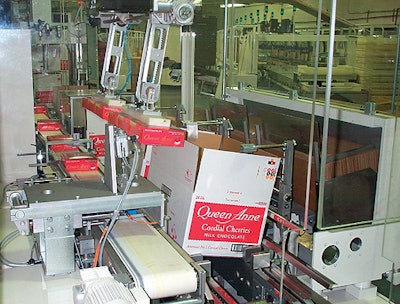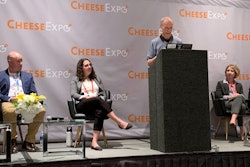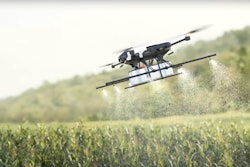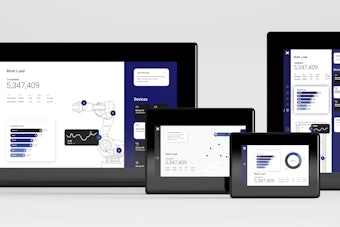
There’s more to Gray & Co., Hart, MI, than the impressive 24-arm, pick-and-place packaging robots featured last month (see packworld .com/go/c059). Downstream, there are even more packaging robots, SMB case loaders from Schubert Packaging Systems (Dallas, TX).
Each robot is equipped with two side-by-side vacuum grippers to load two side-by-side cases simultaneously with rows of cartons. The cartons contain sealed trays of chocolate-covered cherries, or cordials. Schubert handled the integration of the downstream operations that also include a Wexxar (Delta, British Columbia, Canada) WFH-SR case former ahead of the robot and a Wexxar WSH-06 top case sealer following case packing.
The setup of case former, loader, and sealer is duplicated on two parallel production lines and replaces a more labor-intensive, semi-automatic operation
The start-up took place during a week in April 2001, about a month after the upstream tray-packing robots had been in operation. All were part of a $3.1 million automation upgrade at Gray & Co. “The machines have performed well from start-up,” says Judd Marlatt, vice president of operations.
Prior to the installation of the robots, the cases were made up and filled by hand by two operators on each line who then pushed the loaded cases through a top-and-bottom case taper (see packworld.com/go/c057).
Although Schubert provides integrated case forming/loading/sealing machinery, Ben Kirwin, Gray’s special projects engineer, felt the company would gain flexibility by separating these operations.
With a single exception, changeovers on the case former can be completed in 20-30 minutes, Kirwin says. The exception is the case for the 4-oz cartons, because it is much smaller than the other cases. Although packed infrequently, it requires a one-hour changeover.
Marlatt likes the reliability of the Wexxar former, which opens the cases via pins that push into the corrugated rather than vacuum cups. “The cases are formed positively through pin insertion in the flutes of the corrugated,” he notes. “We don’t have to worry about dust accumulation in vacuum cups, worn vacuum cups, or vacuum failure.” The former also glue seals the case bottom before the case is conveyed to the robot.
Tilted loading
At the SMB packing station, two cases are indexed into position on the infeed and are pneumatically tilted 20º away from the robot before loading. This allows the cartons to slide to the far side of the case as they are loaded. After rows of cartons are picked from the infeed and placed into the cases to half fill them, a corrugated divider is inserted before the rest of the rows are loaded to fill the cases. During our visit, 24 16-oz cartons, each containing four trays, were packed per case; each side-by-side robot arm would pick and place three cartons at a time into the case. The robot uses a vacuum-equipped end effector.
The 4- and 8-oz cartons that contain one or two trays are packed at a rate of 90 cartons/min (24 and 36 cartons/case, respectively), 16-oz at a rate of 60/min (24/case), and 24-oz at a rate of 30/min (12/case).
The robots’ major benefits are ease of operation, reliability, and flexibility, Marlatt says.
According to Kirwin, mechanical adjustment is only needed on the SMB robot for a changeover when they run the 4-oz cartons. “All we do is hand-twist the locking bolts, turn and slide the end effector off, replace it with another, and unscrew and screw on the vacuum hose. It takes less than a minute.”
Operations manager Rick Dowty reports that the robot also offered the opportunity to eliminate repetitive-motion injuries associated with case packing. The speed of the robot also eliminates case packing as a line bottleneck, plus the robot requires virtually zero downtime. Robots offer relatively limitless flexibility of different pack sizes through programming changes and tool-less changeover, Dowty says. The SMB operator interface is a touchscreen; program modifications are done using custom Schubert software on a PC.
Cases are discharged from the loader to the Wexxar Model WSH-06 case sealer. As the case enters on the machine conveyor, the front top minor flaps are plowed down and then a pneumatic arm kicks down the trailing minor flap. Glue is applied and the majors are compressed and held until the next case enters the sealer. Case-size changeovers are quickly made using two hand cranks.
Material savings
In addition to labor savings, the change also provided a corrugated savings when Gray switched from a two-piece, top-and-bottom telescoping case to a single-piece RSC case.
“This project saves us about $250ꯠ in packaging materials yearly,” says Marlatt.
The cases are 200# test to 44 ECT, single-wall corrugated that’s flexo-printed in two to three colors by Georgia-Pacific (Atlanta, GA). The robot also inserts into the cases a C/B-flute corrugated divider vertically between the two rows of cartons. It is inserted so that the fluting is vertical to maximize its top-load strength.















